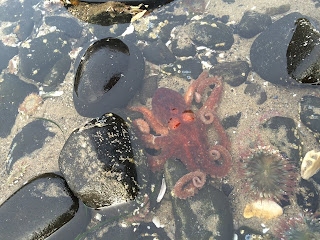An Uncommon Visitor
Every once in a while we receive a visit from an uncommon inhabitant in the tidepools ... this week it was an octopus! It was a small octopus; note the size relative to the anemone in the following picture.
Octopus in the Tidepool
Photo Courtesy of Alanna Kieffer
Octopi have eight arms which typically bear suction cups. The majority of octopi have no internal skeleton or outer shell resulting in an almost completely soft body. The one exception is the beak, made of chitin, similar in shape to a parrot's beak. The soft body allow an octopus to squeeze in and between narrow spaces in rocks where they can hide from predators. They can also eject a thick, blackish ink in a cloud to aid in escaping from prey.
The octopus has a relatively short life, anywhere from 6 months to 5 years for some of the larger species. Reproduction is typically the cause of death; males live only a few moths after mating and females die shortly after their eggs hatch.
Most octopi are subtidal creatures, but smaller species will inhabit tidepools, typically near caves and smaller openings is rocks. An octopus is an uncommon visitor to Haystack Rock so it was a real treat to have one spotted in the tidepools last weekend.
Octopus in the Tidepool
Photo Courtesy of Alanna Kieffer
We hope to see you in the near future on the beach. Perhaps you will spot an uncommon visitor to the tidepools! HRAP Interpreters are on the beach daily at low tide and can answer your questions about the inhabitants of the tidepool.





Simple but interesting post, I loved this very much. Thank you so much for sharing.
ReplyDeletecheap essay writing tips